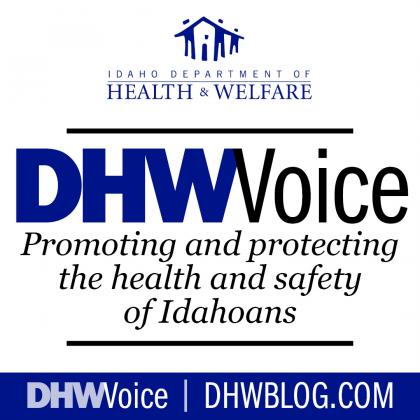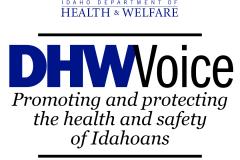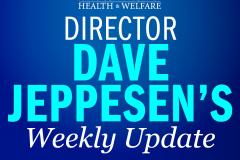Dr. Christine Hahn, Division of Public Health
The monkeypox outbreak has now been declared a global and national public health emergency. Monkeypox is a rare disease caused by infection with the monkeypox virus, which is in the same virus family as the virus that causes smallpox.
Even though Idaho has reported fewer than 10 cases, the Department of Health and Welfare is working closely with the Centers for Disease Control and Prevention (CDC), the Administration for Strategic Preparedness & Response (ASPR), and Idaho’s local public health districts to educate Idahoans about the disease, monitor and prevent monkeypox cases, and provide vaccine and treatment.
What should you do to protect yourself?
Take the following steps to prevent getting monkeypox:
- Avoid close, skin-to-skin contact with people who have a rash that looks like monkeypox.
- Do not touch the rash or scabs of a person with monkeypox.
- Do not kiss, hug, cuddle, or have sex with someone with monkeypox.
- Avoid contact with objects and materials that a person with monkeypox has used.
- Do not share eating utensils or cups with a person with monkeypox.
- Do not handle or touch the bedding, towels, or clothing of a person with monkeypox.
- Wash your hands often with soap and water or use an alcohol-based hand sanitizer, especially before eating, touching your face, and after you use the bathroom.
- If you think you are at high risk of getting monkeypox, talk to your doctor or contact the local public health district about possible vaccination against monkeypox infection.
How is monkeypox spread?
A person with monkeypox can spread it to others from when symptoms start until the rash has fully healed and a fresh layer of skin has formed. The illness typically lasts two to four weeks.
Monkeypox can spread to anyone through close, personal, skin-to-skin contact, including:
- Direct contact with monkeypox rash, scabs, or body fluids from a person with monkeypox.
- Touching objects, fabrics (clothing, bedding, or towels), and surfaces that have been used by someone with monkeypox.
- Contact with respiratory secretions.
This direct contact can happen during intimate contact, including:
- Oral, anal, and vaginal sex, or touching the genitals or anus of a person with monkeypox.
- Hugging, massage, and kissing.
- Prolonged face-to-face contact.
- Touching fabrics and objects during sex that were used by a person with monkeypox and that have not been disinfected, such as bedding, towels, fetish gear, and sex toys.
A fetus can be infected through the placenta.
It’s also possible for people to get monkeypox from infected animals, either by being scratched or bitten by the animal or by preparing or eating meat or using products from an infected animal.
Scientists are still researching:
- If the virus can be spread when someone has no symptoms.
- How often monkeypox is spread through droplets in the air, or when a person with monkeypox symptoms might be more likely to spread the virus through droplets in the air.
- Whether monkeypox can be spread through semen, vaginal fluids, urine, or feces.
Who is most at risk?
People more likely to get monkeypox include:
- People who have been exposed to a person with monkeypox, such as people living in the same household as a person with the disease
- People who had multiple sexual partners in the past two weeks in an area with known monkeypox
- People who have jobs that could expose them to the virus that causes monkeypox, such as laboratory workers who handle or test samples for monkeypox and certain healthcare or public health workers
What are the symptoms of monkeypox?
Monkeypox symptoms usually start within three weeks of exposure to the virus. If someone has flu-like symptoms, they will usually develop a rash one to four days later.
The most common symptom is a rash or sores that can look like pimples or blisters. These may be all over the body or just in certain parts, such as the face, hands, or feet, as well as on or inside the mouth, genitals, or anus.
The rash and sores can be very itchy and painful, and sores in the anus or urethra can make it hard to go to the bathroom. Some people also have flu-like symptoms, such as sore throat, fever, swollen lymph nodes, headache, and tiredness.
People may experience all or only a few symptoms. Sometimes, people have flu-like symptoms before the rash. Some people get a rash first, followed by other symptoms. Others only experience a rash.
What should you do if you think you might have been exposed or even might be infected with monkeypox?
If you have symptoms of monkeypox, you should talk to your healthcare provider about testing, even if you don’t think you had contact with someone who has monkeypox. If you do not have a provider, contact your local public health district. There are no mass testing sites for monkeypox. Testing must be ordered by a healthcare provider.
What is the treatment for monkeypox infection?
Antivirals are available for people with monkeypox. There are no treatments specifically for monkeypox virus infections. Because monkeypox and smallpox viruses are similar, antiviral drugs developed to protect against smallpox may be used to treat monkeypox disease.
If you have symptoms of monkeypox, you should talk to your healthcare provider about testing and possible treatment, even if you don’t think you had contact with someone who has monkeypox.
Are vaccines available in Idaho?
Yes. Vaccines have been provided to every local public health district in the state.
Idaho currently has enough vaccine to vaccinate close contacts of people with monkeypox, and in some cases can provide doses to people at high risk of exposure. If the vaccine is received soon enough after exposure, it may prevent symptoms. Idaho is following the Centers for Disease Control and Prevention (CDC) national vaccine strategy, which recommends vaccine for people who have been exposed to monkeypox and people who might be more likely to get monkeypox.
Do vaccines for chickenpox or shingles prevent monkeypox?
No. Although the name “chickenpox” suggests that the disease is related to monkeypox and smallpox, that is not the case. Varicella, the virus that causes chickenpox, is in the herpes virus family, and is not related to the family of Orthopox viruses that cause smallpox and monkeypox.
Dr. Christine Hahn is Idaho’s state epidemiologist and the Division of Public Health’s medical director. She is board certified in infectious disease and works in an Idaho tuberculosis clinic twice monthly. She also serves on the Centers for Disease Control and Prevention’s Advisory Committee on Immunization Practices.
Follow the Department of Health and Welfare on Twitter, Facebook, and Instagram for updates and information you can trust.
The Idaho Department of Health and Welfare is dedicated to strengthening the health, safety, and independence of Idahoans. Learn more at healthandwelfare.idaho.gov.




Join the Discussion
Please note the following terms of participation in commenting on the DHW Voice blog.
To ensure a productive discussion you agree to post only comments directly related to this post and to refrain from posting obscenities; threatening, abusive or discriminatory language; sexually explicit material; and other material that would violate the law if published here; promotional content; or private information such as phone numbers or addresses. DHW reserves the right to screen and remove inappropriate comments.